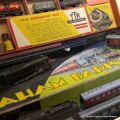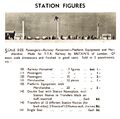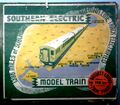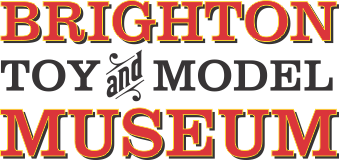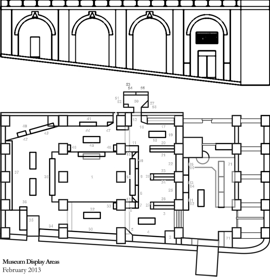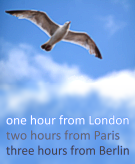Category:Trix: Difference between revisions
BTMM Signe (talk | contribs) m (+ wikilink) |
No edit summary |
||
| (22 intermediate revisions by 3 users not shown) | |||
| Line 1: | Line 1: | ||
{{Toymaker}} | {{Toymaker|Trix_logo_staggered-X.jpg|Trix_logo,_postwar,_perspective_frame.jpg}} | ||
''' | '''[[Trix]]''' was a metal toymaking company founded in Germany between the wars by [[Stefan Bing]] and other ex-''[[Bing|Bing Werke]]'' staff. The company was noted for its technical innovation, and helped to pioneer the new half-size 00/H0 model railway format, with improved models that were a generation further developed than the early half-size locos and sets that had been trialled by the Bing company. | ||
==Origins of Trix Limited== | |||
After the Nuremburg-based [[Bing]] got into financial trouble in the late 1920s, some of the key personnel left and banded together to start a new toymaking business, headed by '''Stefan Bing''' and '''Siegfried Kahn'''. '''Andreas Förtner''''s Nuremburg toymaking company (ANFOE) had already merged with '''J. Haffner''''s in 1925, and the Fortner-Hafner company was bought by the group, moving to larger Nuremburg premises in 1929. An early major product was the new TRIX metal construction sets, and it was decided to set up local offshoot companies in the main countries being exported to, and the first of these was '''Trix Ltd.''', 4 Golden Lane, London EC1, a joint enterprise with Stefan's friend [[W.J. Bassett-Lowke]] in 1932. | |||
With Stefan's Jewish heritage becoming increasing problematic as the Nazi party gained ascendancy, Stefan began to concentrate more on his links with England and Bassett-Lowke, with B-L designing British-outline bodyshells for the new trains. | |||
As the situation in Germany worsened, B-L "took in" Trix and Stefan Bing, with manufacturing at [[Winteringham|Winteringham Ltd., Northampton]]. | |||
==Trix metal construction sets== | ==Trix metal construction sets== | ||
{{Box|Moto_Trix_closeup.jpg|close-up of a Trix constructor set, showing the Trix system's three rows of holes}} | {{Box|Moto_Trix_closeup.jpg|close-up of a Trix constructor set, showing the Trix system's three rows of holes|380}} | ||
The TRIX metal construction sets reinvented the [[Meccano]] idea, using a smaller range of more general-purpose plates, punched with three staggered sets of holes that lined up diagonally, suggesting the name '''Tri-X''', or Trix. | |||
These sets looked distinctively different to Meccano, and the three-row system had the advantage of allowing plated to be bolted together rigidly not just in-line but also at right-angles or at 45 degrees without needing any additional side-struts. The main advantage of the system, though, was cost - since Trix plates were used as both wide beams and narrow plates, a Trix set required fewer specialised pieces, and the entry-level Trix sets were much cheaper than their Meccano counterparts. | |||
==Trix | ==Trix Express== | ||
{{Box|TrixTwin_CoronationScot.jpg|Trix Twin Railways promotion for their [[Coronation Scot]] set (1937)}} | {{Box|TrixTwin_CoronationScot.jpg|Trix Twin Railways promotion for their [[Coronation Scot]] set (1937)|380}} | ||
'''[[:Category: Trix Express|Trix Express]]''' was the original Trix model railway system manufactured in Germany. | |||
After the simple and cheap-to-produce TRIX sets, the bankruptcy of Bing Werke in 1932 created a new opportunity, and the next major product line was a range of tabletop train sets inspired and developed from the earlier '''Bing Tabletop Railway''' system that some of the new company's personnel were already intimately familiar with. After some years of development, the Trix Express system was first shown to the public at the 1935 Leipzig Spring Fair. | |||
The Trix Express (and Trix international) names continued to be used on the continent after [[World War Two]]. | |||
Trix | ==Trix Twin Railway (TTR)== | ||
'''[[:Category: Trix Twin Railway|Trix Twin Railway (TTR)]]''' was the next development of the Trix railway range. A patented innovation involved isolating all three rails of a three-rail track to allow individual control over two trains on a single track, by having two locos drawing power from different outer rails, and with the use of two controllers. | |||
With the rise of the Nazi party in Germany causing Stefan Bing and Siegfried Kahn to move to the UK, TTR increasingly became a UK system. | |||
For a while a "difference of vision" between Stefan Bing and [[W.J. Bassett-Lowke]] created a tongue-twisting confusion over whether "TTR" should be presented as standing for "Trix Twin" or "Twin Train" Railway. | |||
==Selected patents== | |||
{{Box|Scientrix_Trix_Electrical_Set_(BL-TTRcat_1938).jpg|1938: Trix "Scientrix" science set |380}} | |||
* [http://worldwide.espacenet.com/publicationDetails/biblio?FT=D&date=19370114&DB=worldwide.espacenet.com&locale=en_EP&CC=GB&NR=459744A&KC=A&ND=4 GB459744 (A) - Improvements in or connected with tracks for toy railways (espacenet.com)] – ''clip-together track'' <small><small><br>VEREINIGTE SPIELWARENFABRIKEN A. FORTNER & J. HAFFNER'S NACHFOLGER GES., 15, Kobergerstrasse, Nuremberg, Germany. Jan. 23, 1936</small></small> | |||
* [http://worldwide.espacenet.com/publicationDetails/biblio?FT=D&date=19360810&DB=worldwide.espacenet.com&locale=en_EP&CC=GB&NR=451644A&KC=A&ND=4 GB451644 (A) - Device for coupling and uncoupling toy vehicles running on rails ] | |||
: <small><small>VEREINIGTE SPIELWARENFABRIKEN A. FORTNER & J. HAFFNER'S NACHFOLGER GES., 15, Kobergerstrasse, Nuremberg, Germany. Feb. 28, 1936</small></small> | |||
* [http://worldwide.espacenet.com/publicationDetails/biblio?FT=D&date=19370430&DB=worldwide.espacenet.com&locale=en_EP&CC=GB&NR=465168A&KC=A&ND=4 GB465168 (A) - Electrical railway toy] – ''The "TTR" patent for running two independent trains on three-rail track'' | |||
: <small><small>VER SPIELWARENFABRIKEN ANDREAS + (VEREINIGTE SPIELWARENFABRIKEN ANDREAS FOERTNER & J. HAFFNER'S NACHFOLGER GESELLSCHAFT MIT BESCHRANKT) Oct. 31, 1935, No. 30095. Convention date, Nov. 28, 1934</small></small> | |||
* [http://worldwide.espacenet.com/publicationDetails/biblio?DB=worldwide.espacenet.com&II=0&ND=3&adjacent=true&locale=en_EP&FT=D&date=19380705&CC=GB&NR=488357A&KC=A GB488357 (A) - Improvements in or connected with toy electric railway vehicles ] – ''uses a reverser relay to switch the colour of the front and rear lights depending on a train's direction of motion'' | |||
* [http://worldwide.espacenet.com/publicationDetails/biblio?FT=D&date=19390111&DB=worldwide.espacenet.com&locale=en_EP&CC=GB&NR=498651A&KC=A&ND=4 Improvements in or connected with remote-control coupling and uncoupling devices for toy electric railways (espacenet.com) ] | |||
{{Links}} | {{Links}} | ||
* [http://de.wikipedia.org/wiki/Trix Trix (German Wikipedia)] | * [http://de.wikipedia.org/wiki/Trix Trix (German Wikipedia)] | ||
* [http://www.trix.co.uk/ Steve White's Trix Twin Model Railway collectors' website (trix.co.uk)] | * [http://www.trix.co.uk/ Steve White's Trix Twin Model Railway collectors' website (trix.co.uk)] | ||
* [http://www.ttrca.co.uk/index.html Trix-Twin Railway Collectors' Association TTRCA (ttrca.co.uk)] | * [http://www.ttrca.co.uk/index.html Trix-Twin Railway Collectors' Association TTRCA (ttrca.co.uk)] | ||
* [http://www.theplatelayers.org/symposium2009/trix.pdf History of Trix (theplatelayers.org)] - ''(.pdf)'' | |||
* [http://www.mremag.com/news/article/trix-british/12466 Trix (British), Model Railway Express Mag (mremag.com)] | |||
{{B-L}} | |||
{{MetCon}} | |||
Latest revision as of 00:37, 24 January 2016
Trix was a metal toymaking company founded in Germany between the wars by Stefan Bing and other ex-Bing Werke staff. The company was noted for its technical innovation, and helped to pioneer the new half-size 00/H0 model railway format, with improved models that were a generation further developed than the early half-size locos and sets that had been trialled by the Bing company.
Origins of Trix Limited
After the Nuremburg-based Bing got into financial trouble in the late 1920s, some of the key personnel left and banded together to start a new toymaking business, headed by Stefan Bing and Siegfried Kahn. Andreas Förtner's Nuremburg toymaking company (ANFOE) had already merged with J. Haffner's in 1925, and the Fortner-Hafner company was bought by the group, moving to larger Nuremburg premises in 1929. An early major product was the new TRIX metal construction sets, and it was decided to set up local offshoot companies in the main countries being exported to, and the first of these was Trix Ltd., 4 Golden Lane, London EC1, a joint enterprise with Stefan's friend W.J. Bassett-Lowke in 1932.
With Stefan's Jewish heritage becoming increasing problematic as the Nazi party gained ascendancy, Stefan began to concentrate more on his links with England and Bassett-Lowke, with B-L designing British-outline bodyshells for the new trains.
As the situation in Germany worsened, B-L "took in" Trix and Stefan Bing, with manufacturing at Winteringham Ltd., Northampton.
Trix metal construction sets
close-up of a Trix constructor set, showing the Trix system's three rows of holes [image info]
The TRIX metal construction sets reinvented the Meccano idea, using a smaller range of more general-purpose plates, punched with three staggered sets of holes that lined up diagonally, suggesting the name Tri-X, or Trix.
These sets looked distinctively different to Meccano, and the three-row system had the advantage of allowing plated to be bolted together rigidly not just in-line but also at right-angles or at 45 degrees without needing any additional side-struts. The main advantage of the system, though, was cost - since Trix plates were used as both wide beams and narrow plates, a Trix set required fewer specialised pieces, and the entry-level Trix sets were much cheaper than their Meccano counterparts.
Trix Express
Trix Twin Railways promotion for their Coronation Scot set (1937) [image info]
Trix Express was the original Trix model railway system manufactured in Germany.
After the simple and cheap-to-produce TRIX sets, the bankruptcy of Bing Werke in 1932 created a new opportunity, and the next major product line was a range of tabletop train sets inspired and developed from the earlier Bing Tabletop Railway system that some of the new company's personnel were already intimately familiar with. After some years of development, the Trix Express system was first shown to the public at the 1935 Leipzig Spring Fair.
The Trix Express (and Trix international) names continued to be used on the continent after World War Two.
Trix Twin Railway (TTR)
Trix Twin Railway (TTR) was the next development of the Trix railway range. A patented innovation involved isolating all three rails of a three-rail track to allow individual control over two trains on a single track, by having two locos drawing power from different outer rails, and with the use of two controllers.
With the rise of the Nazi party in Germany causing Stefan Bing and Siegfried Kahn to move to the UK, TTR increasingly became a UK system.
For a while a "difference of vision" between Stefan Bing and W.J. Bassett-Lowke created a tongue-twisting confusion over whether "TTR" should be presented as standing for "Trix Twin" or "Twin Train" Railway.
Selected patents
1938: Trix "Scientrix" science set [image info]
- GB459744 (A) - Improvements in or connected with tracks for toy railways (espacenet.com) – clip-together track
VEREINIGTE SPIELWARENFABRIKEN A. FORTNER & J. HAFFNER'S NACHFOLGER GES., 15, Kobergerstrasse, Nuremberg, Germany. Jan. 23, 1936 - GB451644 (A) - Device for coupling and uncoupling toy vehicles running on rails
- VEREINIGTE SPIELWARENFABRIKEN A. FORTNER & J. HAFFNER'S NACHFOLGER GES., 15, Kobergerstrasse, Nuremberg, Germany. Feb. 28, 1936
- GB465168 (A) - Electrical railway toy – The "TTR" patent for running two independent trains on three-rail track
- VER SPIELWARENFABRIKEN ANDREAS + (VEREINIGTE SPIELWARENFABRIKEN ANDREAS FOERTNER & J. HAFFNER'S NACHFOLGER GESELLSCHAFT MIT BESCHRANKT) Oct. 31, 1935, No. 30095. Convention date, Nov. 28, 1934
- GB488357 (A) - Improvements in or connected with toy electric railway vehicles – uses a reverser relay to switch the colour of the front and rear lights depending on a train's direction of motion
- Improvements in or connected with remote-control coupling and uncoupling devices for toy electric railways (espacenet.com)
External links
Subcategories
This category has the following 7 subcategories, out of 7 total.
A
- Alcon construction sets (1 P, 8 F)
C
- Trix card models (13 F)
M
- Trix Manyways station sets (20 F)
T
- Trix construction sets (6 P, 30 F)
- Trix Express (3 P, 1 F)
- TTR Presentation Sets (3 P, 3 F)
Pages in category ‘Trix’
The following 24 pages are in this category, out of 24 total.
C
L
M
P
Media in category ‘Trix’
The following 96 files are in this category, out of 96 total.
- American Wood-Burning Engine, card model (Trix1800 SC4).jpg 2,130 × 1,109; 973 KB
- Area 43.jpg 1,024 × 1,024; 619 KB
- Ashfield Station and Southern train set, Bassett-Lowke (MM 1941-09).jpg 1,600 × 618; 198 KB
- Bassett-Lowke advert (SRMT 1939).jpg 1,015 × 1,600; 317 KB
- Bassett-Lowke Twin Train Table Railway 1938 catalogue.jpg 1,326 × 2,000; 803 KB
- Bassett-Lowke Twin Trains (BLcat 1939).jpg 2,000 × 1,321; 573 KB
- Bassett-Lowke, TTR (BL-MR 1937-11).jpg 882 × 1,200; 188 KB
- Box end label for Coronation Scot carriage (Trix Twin Railway).jpg 800 × 799; 381 KB
- Flying Scotsman locomotive, card model (Trix1800 SC3).jpg 1,585 × 764; 560 KB
- Gresley Coach Brake 3rd, card kit, bagged (TrixTrains C2).jpg 1,322 × 2,000; 2.07 MB
- GWR Pannier Tank Engine, card model (Trix1800 SC7).jpg 1,465 × 1,155; 859 KB
- Hamleys 1939 catalogue, page11, Trix Twin Railway TTR (HamleyCat 1939).jpg 936 × 1,200; 350 KB
- Hornes Tramcar, card model (Trix1800 SC1).jpg 1,917 × 1,465; 1.29 MB
- Junior Trix (Trixcat 1964).jpg 1,836 × 2,000; 416 KB
- LMS 4-4-0 locomotive 4-536 (TTRcat 1939).jpg 1,600 × 630; 205 KB
- LNER 4-4-0 locomotive 4-536 (TTRcat 1939).jpg 1,600 × 566; 191 KB
- LNER Gresley Coaches, card models (TrixTrains C1 C2 C3).jpg 2,400 × 961; 1.02 MB
- Mallard locomotive, LNER A4, card model (Trix1800 SC2).jpg 1,594 × 713; 498 KB
- Manyways 02, Narrow Ramp (TTRcat 1939).jpg 883 × 524; 48 KB
- Manyways 04, Wide Ramp (TTRcat 1939).jpg 947 × 574; 64 KB
- Manyways 12-15, Narrow Platform (TTRcat 1939).jpg 1,483 × 709; 101 KB
- Manyways 14-15, Wide Platform (TTRcat 1939).jpg 1,495 × 674; 133 KB
- Manyways 22, Awning Platform (TTRcat 1939).jpg 1,341 × 925; 140 KB
- Manyways 32, Goods Shed (TTRcat 1939).jpg 1,010 × 829; 111 KB
- Manyways 35, Quadrant Piece (TTRcat 1939).jpg 920 × 947; 69 KB
- Manyways 37, Annexe Building (TTRcat 1939).jpg 1,320 × 989; 161 KB
- Manyways 38, Main Building (TTRcat 1939).jpg 1,533 × 1,131; 219 KB
- Manyways 39, Tower Building (TTRcat 1939).jpg 989 × 1,373; 102 KB
- Manyways 42, Span with Celastoid Roof (TTRcat 1939).jpg 1,463 × 1,105; 207 KB
- Manyways 43, Panel for Span or Platform (TTRcat 1939).jpg 932 × 882; 67 KB
- Manyways 44, Single Buffer End (TTRcat 1939).jpg 880 × 564; 39 KB
- Manyways 48, Double Buffer End (TTRcat 1939).jpg 935 × 605; 56 KB
- Manyways 91, Small Steps (TTRcat 1939).jpg 883 × 484; 31 KB
- Manyways 92, Entrance Steps (TTRcat 1939).jpg 901 × 562; 67 KB
- Manyways Shopfronts (TTRGaz5 1939).jpg 2,400 × 1,072; 531 KB
- Manyways station buildings (TTRcat 1939).jpg 976 × 1,600; 325 KB
- Micotrix mains-powered electric motor (French Trix).jpg 1,024 × 768; 392 KB
- Moto Trix box set 25.jpg 1,721 × 1,261; 413 KB
- Moto Trix closeup.jpg 256 × 192; 11 KB
- Moto-Trix No25 Construction Set (BL-TTRcat 1938).jpg 1,354 × 1,665; 283 KB
- Permag electric motor with box (Trix).jpg 1,024 × 574; 393 KB
- Preston Tram Car, card kit, bagged (Trix 1800 Series).jpg 1,925 × 3,000; 4.29 MB
- Pullman TRIX TWIN carriage (TTRcat 1939-).jpg 1,600 × 867; 158 KB
- Royal Scot locomotive, LMS 6100, card model (Trix1800 SC6).jpg 1,586 × 754; 555 KB
- Scientrix Trix Electrical Set (BL-TTRcat 1938).jpg 1,766 × 1,084; 251 KB
- Sewing Machine, Trix Metal Construction Sets (HW 1932-03-12).jpg 2,033 × 2,618; 1.32 MB
- Signal Box and Footbridge, card models (MiniTrix N3).jpg 2,263 × 1,441; 1.77 MB
- Signal Box and Huts, card kit, bagged (TrixTrains 00-3).jpg 2,088 × 3,000; 4.06 MB
- Southern electric three-coach train (TTRcat 1939).jpg 1,600 × 1,200; 309 KB
- Southern Electric train set (BL-TTRcat 1938).jpg 1,332 × 2,000; 701 KB
- Station Building and Station Platform, card models (MiniTrix N1 N2).jpg 2,251 × 1,441; 1.52 MB
- Station Figures, Britains for Trix TTR (BL-TTRcat 1938).jpg 3,107 × 3,080; 783 KB
- Super Trix No 6 Construction Set (BL-TTRcat 1938).jpg 1,306 × 1,376; 173 KB
- Traction Engine, card model (Trix1800 SC5).jpg 1,424 × 1,075; 744 KB
- Tricy Trix advert (Gamages 1932).jpg 935 × 667; 162 KB
- Tricy Trix No14 The Electric Trix (BL-TTRcat 1938).jpg 2,037 × 1,428; 317 KB
- Trix catalogue 1964.jpg 2,200 × 1,715; 455 KB
- Trix clockwork motor.jpg 1,024 × 768; 409 KB
- Trix Complete Engineering Manual (Trixcat 1964).jpg 1,621 × 1,851; 332 KB
- Trix Construction Sets, Patent GB363547.jpg 1,114 × 873; 154 KB
- Trix Crane Truck Set (TTRcat ~1963).jpg 2,069 × 1,221; 373 KB
- Trix Express and Trix International logos, post-war.jpg 853 × 641; 70 KB
- Trix Extra-Pak (Trixcat 1964).jpg 409 × 578; 36 KB
- Trix logo staggered-X.jpg 1,685 × 797; 47 KB
- Trix logo, postwar, perspective frame.jpg 1,242 × 787; 39 KB
- Trix Major Construction Set (BL-TTRcat 1938).jpg 2,793 × 1,645; 372 KB
- Trix Manyways 1939.jpg 2,517 × 1,525; 612 KB
- Trix Master Engineer (Trixcat 1964).jpg 2,000 × 1,387; 410 KB
- Trix Metal Construction Sets (Gamages 1932).jpg 1,951 × 2,292; 464 KB
- Trix Motors (BL-TTRcat 1938).jpg 2,913 × 1,233; 368 KB
- Trix New Metal Construction Set, Hobbies no1899 (HW 1932-03-12).jpg 1,802 × 2,500; 3.55 MB
- Trix No 1, 1a, 2a Construction Sets (BL-TTRcat 1938).jpg 1,500 × 1,794; 302 KB
- Trix No 2 Construction Set (BL-TTRcat 1938).jpg 1,856 × 1,264; 227 KB
- Trix No 3 Construction Set (BL-TTRcat 1938).jpg 2,011 × 1,269; 276 KB
- Trix No 4 Gear Set (BL-TTRcat 1938).jpg 1,378 × 1,651; 247 KB
- Trix No 7 Motor and Gear Set (BLTTRcat 1938).jpg 1,213 × 1,283; 177 KB
- Trix No10 Construction Set with tyres (BL-TTRcat 1938).jpg 1,321 × 1,317; 280 KB
- Trix Permag Electric Motor (Trixcat 1964).jpg 1,393 × 1,101; 133 KB
- Trix Princess.jpg 2,048 × 1,391; 324 KB
- Trix Twin Railway catalogue, 1939-1940.jpg 1,200 × 978; 201 KB
- Trix Twin Railway text.jpg 1,024 × 519; 121 KB
- Trix Twin Railways catalogue cover ~1963.jpg 2,200 × 1,713; 726 KB
- Trix Twin Railways presentation sets.jpg 3,000 × 906; 604 KB
- Trix Tyres (BL-TTRcat 1938).jpg 973 × 997; 141 KB
- Trix Universal Gear Set (BL-TTRcat 1938).jpg 1,752 × 1,129; 286 KB
- TrixTwin CoronationScot.jpg 517 × 493; 39 KB
- TTR catalogue 1939-40 cover.jpg 1,722 × 2,820; 816 KB
- TTR catalogue green Southern electric 1939.jpg 1,025 × 1,285; 235 KB
- TTR Coronation Scot 1939 red US tour set.jpg 1,717 × 2,832; 643 KB
- TTR Gazette Spring 1939.jpg 1,240 × 1,600; 629 KB
- TTR green Southern electric train set (1939).jpg 1,152 × 1,011; 173 KB
- TTR logo summit.jpg 519 × 349; 28 KB
- TTR logo TwoLocos.jpg 469 × 455; 37 KB
- TTR Passengers, Station Staff and Equipment (Trix Twin Railway).jpg 1,024 × 765; 431 KB
- Windmill, Trix Metal Construction Sets (HW 1932-03-12).jpg 1,144 × 1,916; 776 KB






